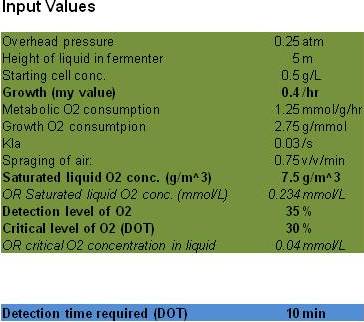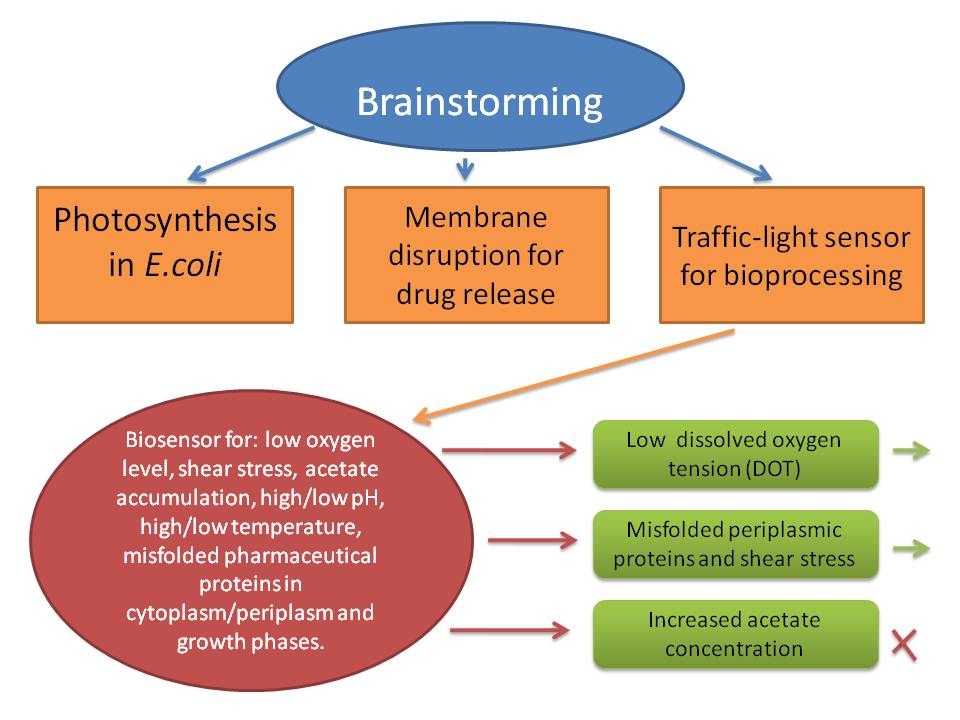Team:UCL London/Project/Approach
From 2009.igem.org
Approach
The Idea
After brain storming project ideas during the spring the team had come up with three ideas we considered not only very interesting but also manageable for a summer project. The three main ideas were:
1. Incorporation of some photosynthetic function into e.coli or characterisation of a small library of photosynthetic related biobricks for prokaryotes.
2. Tightly inducible and well controlled cell membrane disruption for drug release to replace mechanical homogenisation in large scale bioprocessing.
3. Traffic-light stress sensor for bio-processing application. For use within bioprocessing, process design or optimisation we would want examine stresses such as; low oxygen level, shear stress, acetate accumulation, high/low pH, high/low temperature, misfolded pharmaceutical proteins in cytoplasm/periplasm and growth phases.
We decided to make the Traffic-light stress sensor in E.coli and also to narrow our detection range to:
Low oxygen levels
Acetate accumulation
Misfolded proteins
The reason for calibrating our biosensor for the three stresses above is that these stresses seemed to be the most crucial ones for improving general bioprocessing. Literature review introduced us to a possible way to detect misfolded proteins in the periplasm via the two component signal transduction systems CpxAR or BaeSR and the Extracytoplasmic function Sigma-E. Low oxygen levels we thought we should be able to detect via activation of the FNR molecule in anaerobic conditions. Acetate seemed to be just too elusive to be detected in E.coli in a simple way. Long term exposure to acetate can increase transcription of certain flagellar subunits in E.coli but it is unknown how this is controlled. Acetate can also impact the rotation of a flagellum to make the bacteria tumble and change direction. However, we could not come up with a solution of how to translate this into something that can be detected more easily. A eukaryotic DNA binding protein; FacB from ``Aspergillus nidulance`` could possibly be used for acetate detection. At the end we decided that the quest for successfully incorporating a not very well characterised eukaryotic signalling system into a prokaryote would have added to many new layers of complexity into our project. We settled for making a biosensor that could detect low oxygen levels, misfolded proteins in the periplasm and possibly also shear stress.
Devise for detection of low dissolved oxygen tension DOT
E.coli has at least two global regulatory systems to adapt itself for anaerobic growth. These systems are the one component Fnr protein and the two-component Arc system.
After reviewing in the literature what had been done before this project we decided to base our oxygen sensor system on a promoter being activated by Fnr under anaerobic conditions. We based the sequence of this promoter on the promoter sequence of NarK which has been showed to be induced more than 100-fold under anaerobic conditions. When analysing the upstream sequence of NarK and comparing this with the binding region for Fnr we decided to exchange on basepair in an attempt to optimise the affinity for Fnr.
The biobricks are called; BBa_K239005 for the native NarK promoter and BBa_239006 for the modified and shorter modified NarK promoter.
However, initial experimental results have not been able to confirm that the promoters are working as expectedly. Before the experiments the promoters have been incorporated into testing devices by ligateing them upstream of with RBS, GFP and terminator to form the biobricks BBa_K239010 and BBa_K239011. These devises have then been cultivated without access to air and oxygen or in nitrogen sparged media. The native NarK promoter should also be weakly activated by nitrate due to binding sites for the nitrate activated protein NarL. We have not been able to detect this nitrate activation either when cultivating our strains in different concentrations of Sodium nitrate.
In the writing moment we have still not confirmed the sequence of these devices so there is still a risk that something is wrong with the sequence.
Before designing our devise we made a model for oxygen levels in Excel to determine in within what time frame our oxygen sensor would have to respond. The time frame would depend on which oxygen concentration or DOT level the sensor could detect together with other factors such as geometry of fermenter or growth rate depending on strain, media e.tc.
The input table of the model is shown below with the calculated necessary respond time in blue colour. The Excel model can be found in the link at the bottom of the page.

Modeling
Oxygen and Cell concentration model
Description
At a later stage we will consider another stress independently, then build a model on this stress in order to determine the characteristic parameters. Ultimately we will have a joint model for the two stresses and will eventually obtain a recommendation on the environment.
Objectives
The objectives of this model is to determine Oxygen stress levels at which the cells are put at a stress they can not cope with so that the cells begin to decrease in number. Therefore the ultimate objective is to create a model of the kinetics of the E-coli cells in relation to the oxygen stress levels; determining the minimum level of oxygen (kept constant) at which the size of the colony is stable.
From the lab we will verify that the parameters taken are correct. We will also define the percentage error judged admissible.
Equations
We will assume the following equations:
- Equation of growth: x(t)=x0*exp(mu*t)
- x0 is the initial concentration of E Coli
- mu is the growth rate specific to the E Coli
- Growth and decline phases: rx=mu*x(t)
- rx is the volumetric rate of biomass production
- Number of cells at a time t: N=N0*Exp(-kd*t)
- kd is the specific death constant
- N0 is the initial number of cells
- Rate of cells death: rd=kd*N
- N is the number of viable cells
- kd is the specific death constant
- Oxygen uptake rate: Q(t)=Q0*x(t)
- Q0 is the specific O2 uptake rate
- x is the cell concentration
- Rate of oxygen transfer per unit of volume of fluid: Na=kl*a*(Cal*-Cal*)
- kl is the liquid phase mass transfer coefficient
- a is the gas liquid interfacial area per unit of volume of liquid
- Cal* is the oxygen concentration in broth on equilibrium with gas phase
- Cal oxygen concentration in broth
 "
"









